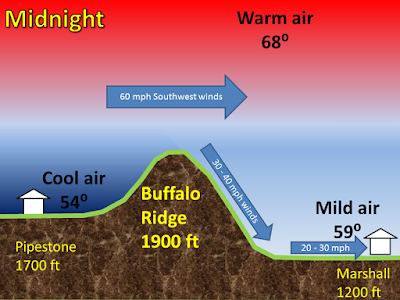Something interesting happened to the temperatures along the
Blue Ridge Mountains this morning. CHO was reporting a temperature of 61 at 3
AM after being at 50 at 9 PM the previous night. The temperature did drop back
in to the mid 50s by 7 AM, but that’s not anywhere close to the mid to upper
30s we were forecasting. I mean, some of us did (as shown below), but a good majority of us were in the 50s, close to 60, at 5 AM. So, what went wrong!?
Well, we had a wind from the southwest much of the overnight. This is a traditionally warmer wind for us and is part of the reason we stayed on the warmer side of our forecast. The other part is we had a downslope wind.
Before we talk about a downslope wind, first let’s talk about the geography of Central Virginia. We have the Blue Ridge Mountains in our backyard and are home to the Blue Ridge Parkway, Skyline Drive and Shenandoah National Park. A lesser known mountain chain, though, is the Southwest Mountains, which extends from Nelson County, through eastern Albemarle County and western Orange County. You can drive along this chain on Route 231 (Gordonsville Rd.) from Route 250 to US 33.
Charlottesville is in a unique position being between these
two mountain chains; it’s part of the reason why cold air damming (CAD) is so
tough to scour out (I’ll elaborate on that in a different blog post) and why
temperature forecasts can be blown.
I mentioned the blown temperature forecast from last night (Thursday, November 10th) being due to the downslope winds. So, what are downslope winds? Here ya go:
I mentioned the blown temperature forecast from last night (Thursday, November 10th) being due to the downslope winds. So, what are downslope winds? Here ya go:
Meteorologists break down the atmosphere in to parcels of air. As one of these parcels of air, think of a square box, rise over the
mountains, the pressure above it lessens. According to the ideal gas law
(PV=nRT), that means the temperature (T) must cool when the pressure (P)
decreases thanks to the volume (V), number of moles (n), and universal gas
constant (R) all remaining constant. The inverse is true when a parcel of air
goes down a mountain; the pressure above the parcel becomes greater which means
the temperature must increase. Here’s a rough schematic of what I’m talking
about: http://www.weather.gov/images/fsd/news/ridge2.png
Another thing to consider is the temperature inside that
parcel of air cooling as it goes up the mountains; the temperature gets closer to the dew
point which then produces clouds. However, the temperature warms as it goes
down the mountain (inverse relationship), meaning there is a wider gap between
the temperature and dew point (dew point depression in meteorological terms) as
the air dries out after having a good bit of moisture wrung out of it from the
parcel’s trip up the mountain. The larger the dew point depression is the less
humidity is inside the parcel of air, which means clouds evaporate and the air dries out. Need some
evidence of this? Check out the dew point drop from 9 PM last night through the
morning hours and how it goes back up by 9 AM:
We see this all the time along the Appalachian Mountains. A
strong northwesterly flow across the Great Lakes runs in to the higher peaks of
the mountain chain. As soon as these parcels of air are lifted up along the
mountains, more clouds form; some of these clouds could also produce showers or
snow depending on the temperature. These clouds then evaporate as they go down
the mountain and are the reason why the Appalachian Mountains could be cloudy,
but we are sunny here across Central Virginia.
David Reese



